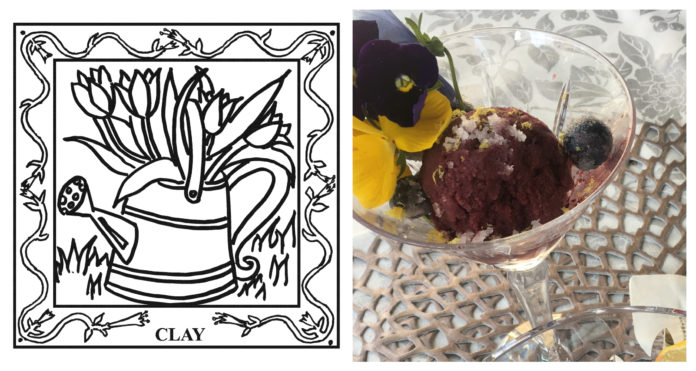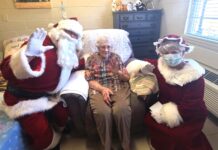
The Cullman Tribune is celebrating the Alabama Bicentennial (1819-2019) with statewide field reporting by Alabama Master Gardener/Botanical Artist Ben Johnson South. This year-long feature, “The 67-County Alabama Garden Party,” will spotlight different counties each week. Each county will get its own “quilt block,” along with a historical profile, and we’ll share a recipe specific to the area. At the end of the year, all 67 counties will be put in a book to commemorate the Bicentennial.
Clay County
Colorful gardens, colorful landscapes, colorful people, colorful Clay County. When it was established in December 1866, this place was thickly forested and emerald green, as much of it still is today. Colors in this sun-infused part of Alabama are more intense. The skies aren’t just blue, they are Cerulean blue.
The soil isn’t simply brown in Clay County; it’s rich, hickory brown, and some of the winding, dirt roads through the emerald forest are paprika red like the spice every respectable cook here dusts on deviled eggs. This is only one of three counties in the state with no federal highway.
Sunshine here isn’t soft and buttery, it’s a gilded, saffron yellow. If Vincent van Gogh had come to America, Clay County, Alabama is where he would have wanted to paint.
Clay County’s most famous, native-born son had the name of a color. He was Supreme Court Associate Justice (1937-1971) Hugo Black, born in the Harlan community in 1886. Considered somewhat liberal in his decisions from the bench, this Alabama gentleman and scholar who was twice on the cover of Time Magazine and honored with his image on a United States postage stamp, was buried at Arlington National Cemetery. His headstone, identical to the tens of thousands of military markers there, simply reads, “Hugo Lafayette Black, Captain, US Army.”
I became familiar with Clay County because of another well-known, and well-loved, colorful native, First Lady of Alabama, Patsy Adams Riley, wife of popular twice-elected Governor Bob Riley, who also served Alabama as a U.S. Congressman. I’ve never met a Riley I didn’t like, but Miz Patsy is the most colorful. I’m pretty sure her first word as an adored and beautiful baby in Ashland, was “MORE!”
Miz Patsy comes by her colorful personality honestly. The apple didn’t fall far from the tree. The First Lady’s mother, Miz Verna Mae, one of Alabama’s adored storytellers, had a full-out, purple bathroom: purple sink, purple tub, purple floor, purple walls, purple towels, purple bathtub, purple throne. It wasn’t shrinking violet, it was, tah dahhh…PURPLE!
Former First Lady Patsy Riley is an avid gardener. She doesn’t just direct gardeners, she loves digging in the dirt. For her, as it is for many of us, planting her garden boots literally in the homeland is spirit-lifting therapy. I happily served as her events chairman at the Governor’s Mansion in Montgomery, and with her guidance we turned an abandoned grove beyond the tennis court into a lovely prayer garden abloom with peaceful, white flowers. The Rileys christened the garden with soaring Alabama gospel music and dinner on the grounds. Governor Riley joined a quartet on the Mansion’s front porch singing one of his favorite hymns, “Beulah Land.”
The Governor’s Mansion was the “Alabama peoples’ house” while the Rileys lived there. Passionate, generous-spirited gardener, Miz Patsy, welcomed hundreds of plant enthusiasts to “Open Garden Days” with free lectures on everything from soil testing to poking posies in sweeping, floral arrangements. As she would say, “Bouquets so big and beautiful that bees and butterflies could flit through the branches.”
Color in a garden, whether it’s sunflower yellow or Alabama state flower red camellia or Japanese iris blue, brings joy and smiles. The most toured monochromatic garden is the white garden created by Vita Sackville-West at her English country estate, Sissinghurst. In America, another favorite to visit for inspiration is The Blue Garden in Newport, Rhode Island designed in 1908 by Frederick Law Olmstead.
Both of those gardens are quite grand, but even modest-sized gardens designed to highlight a single color make a big impact, as do monochromatic container plantings. Here are some plants selected by color that Alabama gardeners should consider:
YELLOW:
GOLDENROD- Perennial, sun to partial shade, flower prolifically in late summer and early fall, disease-resistant
FORSYTHIA- Shrub with big, arching branches laden with bright yellow, star-like flowers that herald springtime at times against bleak, late-winter skies
JONQUIL- Trumpet flowers in the full-range of yellows from palest to deepest, grown from bulbs (e.g. buttercups, daffodils)
YARROW- Perennial with flat flowerheads nicely contrasted with fern-like foliage, summer blooms
GINKO- Fan-shaped leaves turn a brilliant yellow in fall; this is a slow-growing tree so you may want to invest in more mature specimens.
PINK:
RUBRUM LILY- Richly perfumed, large trumpets that are carmine pink dotted with white, grown from bulbs
CLEMATIS- Sun-tolerant and want alkaline soil, this flowering vine comes in a variety of colors, but the pinks are among the most pleasing; provide a trellis or other support structure.
PETUNIA (bubblegum pink)- Annual, loves sun but will hold up in rain and bloom all summer
HYDRANGEA- Substantial shrub, most desire partial shade and moist soil; the globe-shaped heads of flowers come in a wide range of colors and the choice is subjective, but there are some truly splendid pinks.
WHITE:
IMPATIENS- Ideal to punctuate a bit of brightness in a shade garden; shade to partial shade
EUPHORBIA- Annual, sun to partial shade; graceful, lacy flowers
DAISY- Perennial that wants sun to dappled shade
ORANGE:
LANTANA- Annual, sun-loving; butterflies love the blooms that blossom in hottest summer.
DWARF FOTHERGILLA (Fothergilla gardenia)- Shrub, sun to some shade, grows 2-3-feet tall with stunning fall foliage
DAHLIA- Perennial, late-summer flowering and come in a variety of colors, but a great orange hue is “prime time.”
CHINESE LANTERN (Physalis alkekengi)- Bright orange “bladders” enclose a white flower, one of the most child-delighting curiosities in a garden; tolerates sun and partial shade.
CHINESE PISTACIA- Tough but beautiful, wonderful fall color
RED:
LUCIFER (crocosmia)- Perennial, beautiful in cut flower arrangements; multiply readily
PELARGONIUM- Perennial that can be a house or conservatory plant but does well outside in full sun in summer; “Red Elite” is a smashing color.
ROSES- Look for great reds in climbing roses and also in shrub roses, the most-popular fragrant flower.
VERBENA- Useful as a low-growing plant in borders and beds and also cascading from the edge of a container
LENTEN ROSE (Helleborus orientalis)- Evergreen perennial with flowers in a variety of colors, but the dusky reds provide a rich contrast with the bright green leaves.
JAPANESE MAPLE- Decorative tree with leaves that turn bright red in autumn before falling
PURPLE:
ANGELFACE BLUE (Angelonia)- Annual, sun to partial shade, height works nicely in containers surrounded by lower plants, intense purple
IRIS- Perennial; many of the tall bearded varieties are deep purple, the flowers are short-lived with sword-like foliage, most prefer partial shade and wet soil or bog garden conditions.
BLUE:
SALVIAS- Like “May Night,” perennial, want moisture and cool nights
GRAPE HYACINTH (Muscari)- Small bulbs with dense flower spikes, prefer sunny spots
BLUE CHIP BUDDLEIA- Dwarf butterfly bush, blooms all summer, prefers full sun and should be cut back hard in spring
AGAPANTHUS- Perennial, sun to part shade, good to start as bulbs, good container plant with awesome globes of flowers in summer
BLACK- Hugo Black _____? Petunia? Dahlia? Hellebore? Tulip? There’s not one yet but shouldn’t this Clay County-born, great statesman have a colorful, botanical tribute?
The color green is so naturally bountiful in Clay County that it could be taken for granted, but look for shiny leaves of magnolia grandiflora, the proud stands of pines and cedars, the shaded fern glades and the bright, sunny grasses of the meadows. All the greens provide a verdant grounding for this color-filled place and the colorful people who thrive in this part of Alabama.
Here are other positive and pleasurable ways PLANTS + PEOPLE come together in Clay County, Alabama including our original recipe that salutes First Lady Patsy Riley’s mama’s favorite color…PURPLE!!
*CLAY COUNTY FARMERS’ MARKET- 86838 Highway 9, Lineville, AL 36266; Tuesdays 8 a.m.-noon, June 26-August
*CLAY COUNTY PLANTS ADVICE/EDUCATION- Alabama Cooperative Extension System local office at 93 County Road 31, Ashland, AL 36251, 256-354-5976
*PLANTING AN IDEA- Gardens are a wonderful way to teach children colors. Clay County could be a charming location for an ALABAMA CHILDRENS GARDEN OF COLORS. Maybe it’s four planted areas for red, yellow, blue and green. And, the red area, for example, could have strawberries, redbirds, monarch butterflies and an Alabama red camellia. Seems like a great project for some colorful Clay County folks to explore.
Y’ALL COME to Clay County on your 67-County, Alabama Garden Party tour and add some color to your life.
Many thanks to Laurie Johnson for her colorful, purple, people-pleasing recipe for Frozen Grape Sorbet.
Clay County Frozen Purple Heaven Grape Sorbet
This is perhaps the most purple, most elegant and easiest dessert I’ve ever seen, made or eaten. Perfect for a colorful garden party! Fresh Concord grapes only need a little sugar, lemon juice and a tiny bit of effort to transform them into a simple dessert that is ultimately beautiful, satisfying and refreshing. Serve frozen purple heaven with frozen sugared and lemon zested grapes, some fresh mint and edible purple pansies and violas.
Ingredients:
- 1 1/2 lb. purple grapes – seedless and organic if possible
- 1/2 cup sugar plus more for sugared grapes
- 1 tsp. fresh lemon juice and zest from the lemon
- Fresh mint and edible flowers (pansies or violas) for serving
Instructions:
- Wash the grapes and pull them off the stems.
- Reserve a little bunch of grapes for garnish. While they are wet, roll them in granulated sugar and lemon zest and freeze.
- Place the remainder of the grapes, 1/2 cup sugar and lemon juice into a blender and blend until fully liquefied.
- Press the blended mixture through a fine sieve/strainer into a bowl, straining out and discarding solids/seeds (if any) and skins. If the sieve blinds over and quits draining, scrape the good juice off the bottom of the sieve into your juice bowl, rinse the sieve and continue to strain/press the rest.
- Chill the grape juice mixture for an hour or more and process in an ice cream machine as directed. (If no ice cream machine, freeze in a shallow pan and scrape out like a granita.)
- Move the sorbet from the ice cream machine into an air-tight storage bowl and keep frozen.
- To serve, scoop grape sorbet balls into chilled compote bowls or pretty glasses. Tip – Sorbet melts quickly, so you might think about scooping balls onto a pan and re-freezing the balls – they will last longer when you serve. Garnish with the reserved frozen grapes, some of the frozen sugar and zest that will inevitably fall off them, a fresh lemon slice, edible purple pansies or violas and fresh mint leaves to serve.
Also, check out Alabama Bicentennial: 200 ways to save Alabama for the next 200 years.
Copyright 2019 Humble Roots, LLC. All Rights Reserved.
































